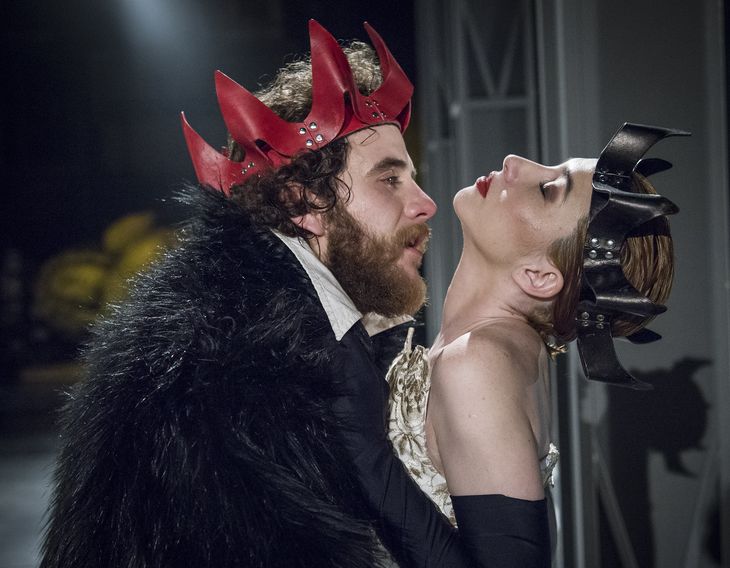“While LGBTQ content is prohibited in the Nation, the San Martin Theater in the City of Buenos Aires houses this content in its main hall, the first work to put homosexuality at the center of the scene. The management at the national level in culture and other areas is disastrous, Cervantes returned to hegemonic and classic content,” says Alejandro Tantanian, former director of the Cervantes National Theater who presents his stage version with Carlos Gamerro and Oria Puppo of “Eduardo II” by Christopher Marlowe in the main room of the San Martín Theater, the Martín Coronado. It can be seen from Wednesday to Sunday until December 15.
Renamed “The tragic reign of Edward II, the sad death of his beloved Gaveston, the intrigues of Queen Elizabeth, and the rise and fall of the arrogant Mortimer,” follows the story of an excessive king, driven by his desires and fascinated with power. A ruler aware of his responsibilities but who tried to combine the good of the kingdom with his personal happiness, which triggered the tragedy.
The cast is made up of Agustín Pardella, Sofía Gala Castiglione, Patricio Aramburu, Eddy García, Luciano Suardi, Santiago Pedrero, Gabo Correa, Lalo Rotaveria, Sergio Mayorquín, Francisco Bertín, Matías Marshall, Belisario Sánchez Dansey, Byron Barbieri, Martín Antuña and Esteban Pucheta. The dancers are Juan Martín Ahumada, Agustín Farfán, Ignacio Fittipaldi, Valentina Gauthier, Candela Navarro and Agustín Salinas. We spoke with Tantanian.
DSC_9439.Eduardo II Tantanian-Puppo-Gamerro-ctba photo Carlos Furman (2).jpg
Journalist: What axes prevail in this reversal that were perhaps hidden in the original?
Alejandro Tantanian: Marlowe’s play is the first in Western dramatic literature to put a homosexual relationship center stage. In general, the English versions take this situation as something secondary or an excuse compared to the weak, quote-unquote, government of Edward. They see the weakness of the government because it attends to their private affairs so we put that relationship at the center, crystallized by Derek Jarman’s film. That homosexual relationship, which was always something very common, was put on the sidelines, there was talk of the king’s favorites and that it had to remain private because making it public was a sin. The hypothesis is what happens if someone comes to government and is openly homosexual, what happens if there is a queer or queer reign. This is not something that sanctifies the LGBTQ community, on the contrary, it problematizes the benefits and darknesses, it presents them as people. There are areas of darkness and abuse of power in these characters, what responds to the regulations or hegemony of power is totally disproportionate to the possible excesses that this government may carry out. A government run by someone who is homosexual is stigmatized and the government is called bad because of sexuality. This reading has not yet been made in the theater, where Eduardo’s government was always presented as weak because instead of addressing public issues it attended to private ones. It is actually he who decides to erase the boundary between both issues.
Q: How does Marlowe take Shakespeare’s “Richard II”?
AT: It is a complex figure. Marlowe takes this king and generates a spectacular echo, the play did very well. It was written in 1582 and Shakespeare never forgot it because it did so well. Eduardo is more opaque in Shakespeare’s text, Marlowe on the other hand writes a work that goes against institutions, the family, the church, military and political power. Marlowe is someone of enormous freedom and the father of English theater. Not for nothing did he end up murdered in a dark brawl in a tavern, with a stab wound in the eye. His murderers were immediately released, it is known that Marlowe was a spy, a confessed atheist, a confessed homosexual, a character that seemed important to get rid of. His Edward II is a testament to his own death, Edward’s death is horrible, a hot iron is inserted into his anus until he dies and that leaves no visible trace. This historical figure is even relevant where the national government prohibits LGBTQ content in an act of clear censorship. As Milei raises the issue of the ass, that privately one can do what they want but not in public. a bit of what Marlowe brings by making it public.
Q: How did you think about the artistic areas of set design, lighting and costumes?
AT: Given which work has many private scenes of two, indoors, our idea was to generate an open space. We use the Martín Coronado room without legs, completely open, there are no curtains to cover. There are some majestic, factory columns and we appeal to the use of anachronism for clothing and scenery. It is interesting because it is a text from yesterday and today, there is blurring of boundaries between the public and the private in that open space, without walls, everything in sight, even the actors who leave and the public continues to see them, there is a lot actors pass. The costumes present an enormous profusion of different materials that generates anachronism. They seem to be epic and at the same time contemporary, with fluo sneakers and plastic flowers. There is leather, fur, a very powerful work on the visual level that is ratified by the use of the video that accompanies the work. The video is not narrative, it works on close-ups of the characters, it creates proximity in a huge space, it acts like a zoom in and zoom out. There are a kind of characters watched by others in the power games in the palace. This is also close to the present with the stories of Alberto and Fabiola.
DSC_9360.Eduardo II Tantanian-Puppo-Gamerro-ctba photo Carlos Furman (2).jpg

Q: How did you work in the official theater?
AT: In our production there are credits at the end where we record the theater workers, there were 400 in total for this play. The San Martín continues to be a factory theater, with makeup, shoe shops, props, a huge number of people who make the public theater continue to be what it is and distinguish itself from the rest. Because it is a public theater, it can host a production of 21 actors on stage, with quality scenery, costumes and video, thanks to the workers who make it possible. We are the visible face but in this show we wanted to value those workers.
Q.: You were director of the Cervantes, how is that national theater today?
AT: I was a director for 3 years and I left 2020 scheduled, which due to the pandemic was extended with works until the 23rd. The theater is adjusting to what it was before our management, returning to the hegemonic models and Argentine classics. We had tried to generate a contemporary theater in our management and we returned to a space where a certain thing is done and not another when a space can mutate and be permeable. But tradition and hegemony seem to be more important than the needs for change.
Q: What can you say about theater and culture today?
AT: It continues to be an incredible place in creation, strength, energy, singularity with voices from different generations but the national culture of this government is disastrous, it breaks with everything that is built, we are a focus of attack. The writers, the members of the culture, are attacked with a certain scorn and morbid dedication. You have to keep working and move forward. In the City it is different because while in the Nation LGBTQ content is prohibited, the San Martin de la Ciudad houses that content in its largest room. So we are at the antipodes of the cultural policy of this extreme right government. There will always be things to fix but in the City there is not the slightest problem in raising issues while in the Nation culture is being devastated, just look at what is happening with the INCAA, INT and the defunding of public spaces.
Source: Ambito
David William is a talented author who has made a name for himself in the world of writing. He is a professional author who writes on a wide range of topics, from general interest to opinion news. David is currently working as a writer at 24 hours worlds where he brings his unique perspective and in-depth research to his articles, making them both informative and engaging.




